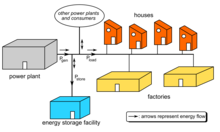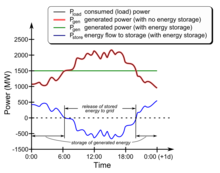

Grid energy storage (also called large-scale energy storage) is a collection of methods used for energy storage on a large scale within an electrical power grid. Electrical energy is stored during times when electricity is plentiful and inexpensive (especially from variable renewable energy sources such as wind power and solar power) or when demand is low, and later returned to the grid when demand is high, and electricity prices tend to be higher.
As of 2023[update], the largest form of grid energy storage is pumped-storage hydroelectricity, with utility-scale batteries and behind-the-meter batteries coming second and third.[1] Developments in battery storage have enabled commercially viable projects to store energy during peak production and release during peak demand, and for use when production unexpectedly falls giving time for slower responding resources to be brought online. Two forms of storage are suited for seasonal storage: green hydrogen, produced via electrolysis and thermal energy storage. As the round-trip efficiency is low, significant hydrogen needs to be stored.[2]
Energy storage is one option to making grids more flexible. An other solution is the use of more dispatchable power plants that can change their output rapidly, for instance peaking power plants to fill in supply gaps. Demand response can shift load to other times and interconnections between regions can balance out fluctuations in renewables production.[3]
- ^ Cozzi, Petropoulos & Wanner 2024, p. 68.
- ^ IPCC AR6 WG3 Ch6 2022, pp. 653, 656.
- ^ IPCC AR6 WG3 Ch6 2022, p. 651.